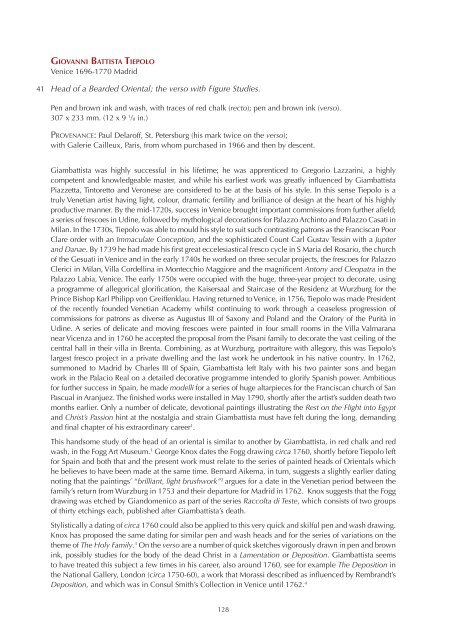Catalogue-2014-Jean-Luc-Baroni
- No tags were found...
Create successful ePaper yourself
Turn your PDF publications into a flip-book with our unique Google optimized e-Paper software.
Giovanni Battista Tiepolo<br />
Venice 1696-1770 Madrid<br />
41<br />
Head of a Bearded Oriental; the verso with Figure Studies.<br />
Pen and brown ink and wash, with traces of red chalk (recto); pen and brown ink (verso).<br />
307 x 233 mm. (12 x 9 1 /8 in.)<br />
Provenance: Paul Delaroff, St. Petersburg (his mark twice on the verso);<br />
with Galerie Cailleux, Paris, from whom purchased in 1966 and then by descent.<br />
Giambattista was highly successful in his lifetime; he was apprenticed to Gregorio Lazzarini, a highly<br />
competent and knowledgeable master, and while his earliest work was greatly influenced by Giambattista<br />
Piazzetta, Tintoretto and Veronese are considered to be at the basis of his style. In this sense Tiepolo is a<br />
truly Venetian artist having light, colour, dramatic fertility and brilliance of design at the heart of his highly<br />
productive manner. By the mid-1720s, success in Venice brought important commissions from further afield;<br />
a series of frescoes in Udine, followed by mythological decorations for Palazzo Archinto and Palazzo Casati in<br />
Milan. In the 1730s, Tiepolo was able to mould his style to suit such contrasting patrons as the Franciscan Poor<br />
Clare order with an Immaculate Conception, and the sophisticated Count Carl Gustav Tessin with a Jupiter<br />
and Danae. By 1739 he had made his first great eccelesiastical fresco cycle in S Maria del Rosario, the church<br />
of the Gesuati in Venice and in the early 1740s he worked on three secular projects, the frescoes for Palazzo<br />
Clerici in Milan, Villa Cordellina in Montecchio Maggiore and the magnificent Antony and Cleopatra in the<br />
Palazzo Labia, Venice. The early 1750s were occupied with the huge, three-year project to decorate, using<br />
a programme of allegorical glorification, the Kaisersaal and Staircase of the Residenz at Wurzburg for the<br />
Prince Bishop Karl Philipp von Greiffenklau. Having returned to Venice, in 1756, Tiepolo was made President<br />
of the recently founded Venetian Academy whilst continuing to work through a ceaseless progression of<br />
commissions for patrons as diverse as Augustus III of Saxony and Poland and the Oratory of the Purità in<br />
Udine. A series of delicate and moving frescoes were painted in four small rooms in the Villa Valmarana<br />
near Vicenza and in 1760 he accepted the proposal from the Pisani family to decorate the vast ceiling of the<br />
central hall in their villa in Brenta. Combining, as at Wurzburg, portraiture with allegory, this was Tiepolo’s<br />
largest fresco project in a private dwelling and the last work he undertook in his native country. In 1762,<br />
summoned to Madrid by Charles III of Spain, Giambattista left Italy with his two painter sons and began<br />
work in the Palacio Real on a detailed decorative programme intended to glorify Spanish power. Ambitious<br />
for further success in Spain, he made modelli for a series of huge altarpieces for the Franciscan church of San<br />
Pascual in Aranjuez. The finished works were installed in May 1790, shortly after the artist’s sudden death two<br />
months earlier. Only a number of delicate, devotional paintings illustrating the Rest on the Flight into Egypt<br />
and Christ’s Passion hint at the nostalgia and strain Giambattista must have felt during the long, demanding<br />
and final chapter of his extraordinary career 1 .<br />
This handsome study of the head of an oriental is similar to another by Giambattista, in red chalk and red<br />
wash, in the Fogg Art Museum. 1 George Knox dates the Fogg drawing circa 1760, shortly before Tiepolo left<br />
for Spain and both that and the present work must relate to the series of painted heads of Orientals which<br />
he believes to have been made at the same time. Bernard Aikema, in turn, suggests a slightly earlier dating<br />
noting that the paintings’ “brilliant, light brushwork” 2 argues for a date in the Venetian period between the<br />
family’s return from Wurzburg in 1753 and their departure for Madrid in 1762. Knox suggests that the Fogg<br />
drawing was etched by Giandomenico as part of the series Raccolta di Teste, which consists of two groups<br />
of thirty etchings each, published after Giambattista’s death.<br />
Stylistically a dating of circa 1760 could also be applied to this very quick and skilful pen and wash drawing.<br />
Knox has proposed the same dating for similar pen and wash heads and for the series of variations on the<br />
theme of The Holy Family. 3 On the verso are a number of quick sketches vigorously drawn in pen and brown<br />
ink, possibly studies for the body of the dead Christ in a Lamentation or Deposition. Giambattista seems<br />
to have treated this subject a few times in his career, also around 1760, see for example The Deposition in<br />
the National Gallery, London (circa 1750-60), a work that Morassi described as influenced by Rembrandt’s<br />
Deposition, and which was in Consul Smith’s Collection in Venice until 1762. 4<br />
128
















